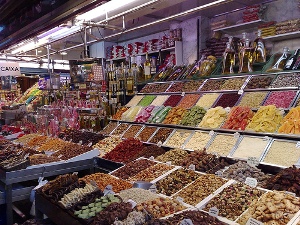Shopping
 Shopping offers an interesting perspective of a country’s culture. In Spain, this is particularly true if you want to explore the food markets, vintage antique stores and flea markets.
Shopping offers an interesting perspective of a country’s culture. In Spain, this is particularly true if you want to explore the food markets, vintage antique stores and flea markets.
Generally the stores in the older city neighborhoods are run by families and still offer the traditional shopping experience, while supermarkets started to appear in the suburbs.
Shopping hours
Shopping hours vary between regions, cities and types of markets. The “siesta” (afternoon break) lasts from 1:30 PM to 2 PM and in some places to 5 PM, while the supermarkets are open without a break for siesta.
Stores open around 8:30 AM -9:30 AM (even earlier if they are food stores), close for the siesta and open again around 5 PM (the latest) until 7:30 PM-9 PM.
Supermarkets and department stores are generally open from 9:30 AM-10 AM to 8 PM-10 PM from Monday to Saturday.
Most of the stores are closed on Sundays, while some might be closed on Mondays as well.
Markets open at around 9:00 AM and close by 2 PM. There are three types of markets in Spain: the indoor markets (called “mercados”), the permanent street markets and the traveling open-air street markets.
Shopping streets and markets
Madrid and Barcelona are the best cities in Spain to go shopping, regardless of what you’re looking to buy.
The best shopping experience in Madrid is definitely a visit at the Rastro Market, where travelers can bargain and experience a real Spanish market. If you are looking to buy quality clothes and shoes walk along Serrano street, while if you want some souvenirs head to Puerta del Sol or Gran Via.
If you plan to visit Barcelona, walk along the world famous Las Ramblas. Let’s just say that it will be a very “colorful” experience, with street performers, painters and birds for sale. If you want to avoid the international labels –which can be found on Diagonal – you should check out the narrow streets of El Born. Although not “recognized” as a shopping area, the stroll in the old city combined with a lot small traditional shops will offer a great Spanish shopping experience. In the Roman center of the city you will find small antique shops and a lot of new designers’ shops.
Sales seasons
There are two main sales seasons in Spain (as in the entire Europe): summer sales and winter sales. If you have enough time to spend checking out the stores you can literally go home with a new wardrobe and a lot of money saved.
Summer sales generally start around mid-July and last until the end of August, although you can find small (as in 20%) discounts several weeks before the start of the sales.
Winter sales start around mid-January and end on the last day of February (29th in 2008).
Specialties
If you are not here for the clothes, you might want to check out the Spanish ceramics, pottery, embroidery, jewelry and painting. Spanish arts and crafts are still among the best you can find in Europe.
Tips
Spaniards don’t really care about queuing and people often shove their way in front. So when it’s your turn, make sure you are heard. The last person in line is called “La ultima” so make sure to answer if you are asked and ask yourself. Foreigners might complain about the services, but it’s not that bad as it seems. Some Spanish sure comes in handy though.
In Barcelona, try the Tomb bus, a unique service which brings you directly to the interesting shopping locations. The fare is little over a Euro per ride and you can jump off at any of the 28 stops.